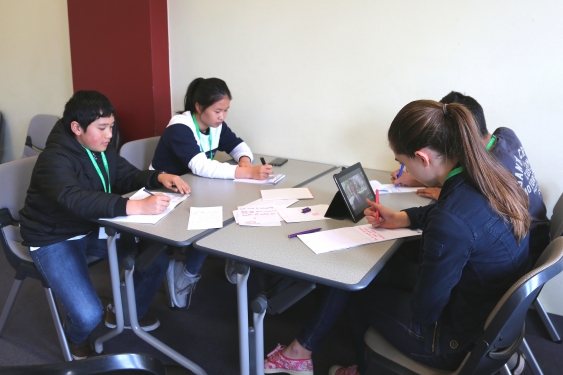Australia's gifted children look to a sustainable future
A UNSW program for gifted children is engaging some of Australia's brightest youngsters with problems their elders have struggled to solve.
A UNSW program for gifted children is engaging some of Australia's brightest youngsters with problems their elders have struggled to solve.

What makes a sustainable community? Bike paths? Proximity to farmers’ markets? Recycling depots?
According to one group of thinkers, a sustainable community is not just about public transport, renewable energy and locally produced food.
“The mental health of the citizen is very important,” says 15-year-old William Harris. “It is not just about having environmental sustainability but also human sustainability.”
The Blue Mountains teenager is one of 18 gifted teenagers taking part in a Youth Summit at UNSW’s Kensington campus focusing on how to create sustainable communities.
Working in small groups, the children are identifying issues planners would face designing a sustainable community in one of three selected environments in Australia, and thinking about possible solutions.
The Summit, run by GERRIC within the UNSW School of Education, is part of the Australian Association for Education of the Gifted and Talented (AAEGT) National Gifted Conference. The conference is being hosted by the School in partnership with the AAEGT and Gifted Families Support Group Inc (GFSG Inc).
About 10 per cent of an estimated 3.7 million children enrolled in Australian schools qualify as gifted (generally, students who are capable of performing in the top 10 per cent of their age-peers). These children have suffered the largest declines in achievement during recent years, according to GERRIC senior research fellow in the UNSW School of Education, Dr Jennifer Jolly.
In a recent opinion piece, Dr Jolly says inconsistent, varied and inadequate support for Australia's gifted and talented students means many of them do not learn anything new until midway through the school year.
The Youth Summit, open to gifted students in Years 7 to 12, provides participants with a chance to work with other gifted children.
Youth Summit creator and facilitator Dr Denise Wood isn’t surprised by how much the participants already know about sustainability. She says gifted children often think about how things will work in the future.
“The point of the youth summit is to allow the children to solve a problem or tackle a real issue, a problem that as adults they might have to deal with, in this case, designing a sustainable community,” says Dr Wood, from the School of Teacher Education at Charles Sturt University.
“It is modelling this particular pedagogy of problem solving with gifted children. It is about challenging them not to give me the one answer they think I want, but to come up with lots of solutions. The program doesn’t just engage gifted children, it gets them engaging with each other.”
Twelve-year-old Sophia Schulz from British Columbia, Canada, who is participating in the Summit, knows that a truly sustainable community can be achieved only if everyone is valued for their contributions.
“We are looking at the value of different age groups and how they can help build a community,” she says.
“We thought about the different jobs older people could do; they could help in a library with children, telling them stories. They have their own opinions about how the world can work, they were alive before iPhones and video games were invented, and they can teach us a lot.”
The National Gifted Conference concludes on Saturday.